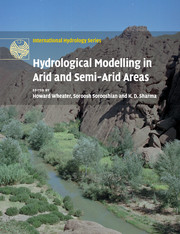Book contents
- Frontmatter
- Contents
- List of contributors
- Preface
- Acknowledgements
- 1 Modelling hydrological processes in arid and semi-arid areas: an introduction
- 2 Global precipitation estimation from satellite imagery using artificial neural networks
- 3 Modelling semi-arid and arid hydrology and water resources: The southern Africa experience
- 4 Use of the IHACRES rainfall-runoff model in arid and semi-arid regions
- 5 KINEROS2 and the AGWA modelling Framework
- 6 Ephemeral flow and sediment delivery modelling in the Indian arid zone
- 7 The modular modelling system (MMS): a toolbox for water and environmental resources management
- 8 Calibration, uncertainty, and regional analysis of conceptual rainfall-runoff models
- 9 Real-time flow forecasting
- 10 Real-time flood forecasting: Indian experience
- 11 Groundwater modelling in hard-rock terrain in semi-arid areas: experience from India
- Appendix Access to software and data products
- Index
- Plate section
- References
2 - Global precipitation estimation from satellite imagery using artificial neural networks
Published online by Cambridge University Press: 15 December 2009
- Frontmatter
- Contents
- List of contributors
- Preface
- Acknowledgements
- 1 Modelling hydrological processes in arid and semi-arid areas: an introduction
- 2 Global precipitation estimation from satellite imagery using artificial neural networks
- 3 Modelling semi-arid and arid hydrology and water resources: The southern Africa experience
- 4 Use of the IHACRES rainfall-runoff model in arid and semi-arid regions
- 5 KINEROS2 and the AGWA modelling Framework
- 6 Ephemeral flow and sediment delivery modelling in the Indian arid zone
- 7 The modular modelling system (MMS): a toolbox for water and environmental resources management
- 8 Calibration, uncertainty, and regional analysis of conceptual rainfall-runoff models
- 9 Real-time flow forecasting
- 10 Real-time flood forecasting: Indian experience
- 11 Groundwater modelling in hard-rock terrain in semi-arid areas: experience from India
- Appendix Access to software and data products
- Index
- Plate section
- References
Summary
INTRODUCTION
Precipitation is the key hydrologic variable linking the atmosphere with land-surface processes, and playing a dominant role in both weather and climate. The Global Water and Energy Cycle Experiment (GEWEX), recognizing the strategic role of precipitation data in improving climate research, strongly emphasized the need to achieve global measurement of precipitation with sufficient accuracy to enable the investigation of regional to global water and energy distribution. Additionally, many other international research programs have also placed high priority on the development of reliable global precipitation observation.
During the past few decades, satellite-sensor technology has facilitated the development of innovative approaches to global precipitation observations. Clearly, satellite-based technologies have the potential to provide improved precipitation estimates for large portions of the world where gauge observations are limited. Recently many satellite-based precipitation algorithms have been developed (Ba and Gruber, 2001; Huffman et al., 2002; Joyce et al., 2004; Negri et al., 2002; Sorooshian et al., 2000; Tapiador 2002; Turk et al., 2002; Vicente et al., 1998; Weng et al., 2003). These algorithms generate precipitation products consisting of higher spatial and temporal resolution with potential to be used in hydrologic research and water-resources applications. Evaluation of recently developed precipitation products over various regions is ongoing (Ebert, 2004; Kidd, 2004; Janowiak, 2004).
In this chapter, we will introduce one near-global precipitation product generated from the PERSIANN (Precipitation Estimation from Remotely Sensed Information using Artificial Neural Networks) algorithm.
Information
- Type
- Chapter
- Information
- Hydrological Modelling in Arid and Semi-Arid Areas , pp. 21 - 28Publisher: Cambridge University PressPrint publication year: 2007
